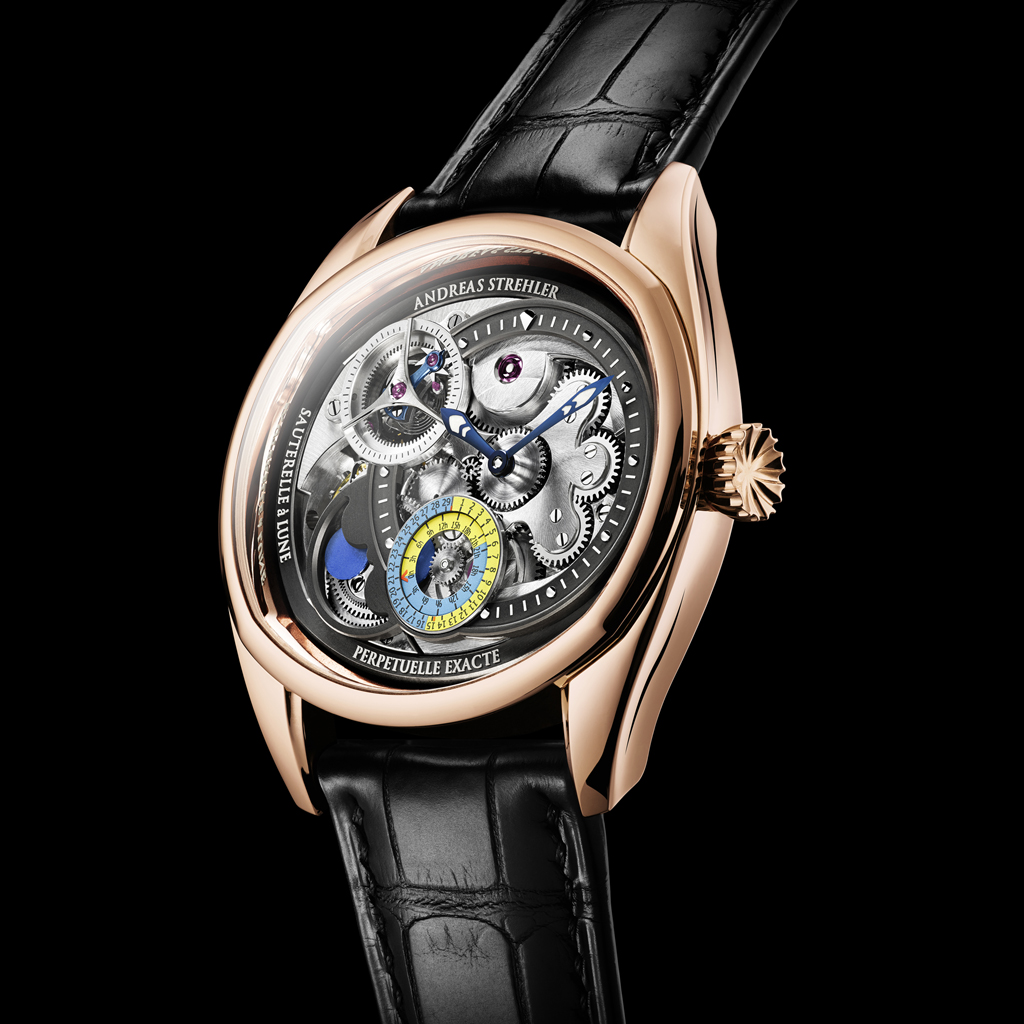
Lune Exacte
Power reserve: 78 h, 21600 variations / hours
The phase of the moon display of the Lune exacte deviates by 1 day from the mean moon in 2'060'757 years, a Guinness Book World record. This phase of the moon can now be set and read extremely accurate to 3 hours thanks to a patent pending Vernier scale on the dial.
The Phase of the Moon indication – a cultural legacy
The phases of the moon have always had a great meaning for mankind. The height of the tide, sowing and harvesting, all depends of the phase of the moon.
Historically, the phases of the moon are in fact the basis of every calendar: Originally, each of the four phases of the moon, i.e. new moon, waxing half-moon, full moon and waning half-moon, determined the duration of a week. All four phases of the moon or one full cycle of the moon determined almost the length of one month.
All these facts make the phase of the moon an interesting and popular indication on a wristwatch. Ideally, such a phase of the moon indication should not deviate from the actual phase of the moon, be easy to read and set and also indicate the precise age of the moon.
Precise phase of the moon indications deviate from the synodic or mean moon by one day after a couple of hundred years; Andreas Strehler's phase of the moon after two million years. This has won the Sauterelle à lune perpetuelle an entry in the Guinness Book of World Records.
World's most accurate moon age indication
However, all phase of the moon indications have a common problem: As precise as they may be, they cannot be read very precisely: Except at new moon and at full moon, the wearer of the watch has to guess what the exact phase or age of the moon is. Also the exact setting of the moon phase indication is only possible at new moon and full moon.
Andreas Strehler’s solution presents the first precise phase of the moon indication that can be read and set with a precision of three hours at any time and not only every fortnight. Thanks to its new and patent pending mechanism. This high precision moon age indication gives the age of the moon in days and further increments of three hours.
Moon Vernier scale
Besides a conventional phase of the moon indication, the additional moon Vernier scale at six o'clock indicates the moon age accurate to three hours. On this high precision moon age scale, a red arrow indicates the age of the moon in days. Two red marks on the scale indicate new moon and full moon.
A Vernier scale on the inner Vernier ring increases the accuracy of the indication to three hours.
Using the moon Vernier is straightforward:
1. The red arrow indicates the age of the moon in days.
2. If the red arrow points to a number in the blue sector of the outer scale (e.g. image 3, 27days), the accurate value is also read from the blue sector of the inner Vernier ring. The age of the moon accurate to three hours is indicated where the next mark on the Vernier ring aligns with a mark on the outer ring (e.g. image 3, 3 hours).
3. These hours are added to the days indicated on the outer ring. (e.g. image 3, 27days + 3 hours)
In the same way, if the red arrow indicates a day on the yellow sector of the outer scale, the hours are also read from the yellow sector on the Vernier scale. (e.g. image 2, 5 days, 18 hours)
For this moon Vernier scale a patent is pending.
Patented remontoir d'égalité – regulated energy
In addition to the patent pending moon age indication, the Lune exacte also has Andreas Strehler's patented remontoir d'égalité.
Conventionally, a complication known as force constante (constant force) acts on the escape-wheel. However, this is the point in the whole movement where the least torque is present. For this reason, Andreas Strehler's remontoir d'égalité is attached to the seconds wheel or fourth wheel.
This solution has the advantage that the complete escapement including the escapement wheel oscillates free from any influence between the individual impulses delivered by the remontoir d'égalité. Hence, the Swiss Anker Escapement performs without influence from the remontoir d'égalité, with its precision perfected over the last 200 years.
Fluctuations in the energy supply as well as flaws in the functioning of the gear train (uneven working of the mainspring, the gear train or the motion-work of the hands) are filtered and equalised by the remontoir d'égalité. In contrast to a force constante and its fixed division ratio, which demands a frequency of 18.000 A/h, the Remontoir d'égalité can be used with any frequency. The Sauterelle therefore has a frequency of 21.600 A/h which leads to higher precision.
With the Remontoir d'égalité, Andreas Strehler concentrates on the elimination of external factors such as temperature. Even minor changes in temperature influences the viscosity of the lubricants used in the mainspring barrels and consequently the even running down of the mainsprings.
Optimal transmission of power
All watches made by Andreas Strehler show an almost linear force path as the running down of the two mainsprings is limited by a epicyclic gear stop work. Only the optimal part of each mainspring is used where the thrust produced is constant.


